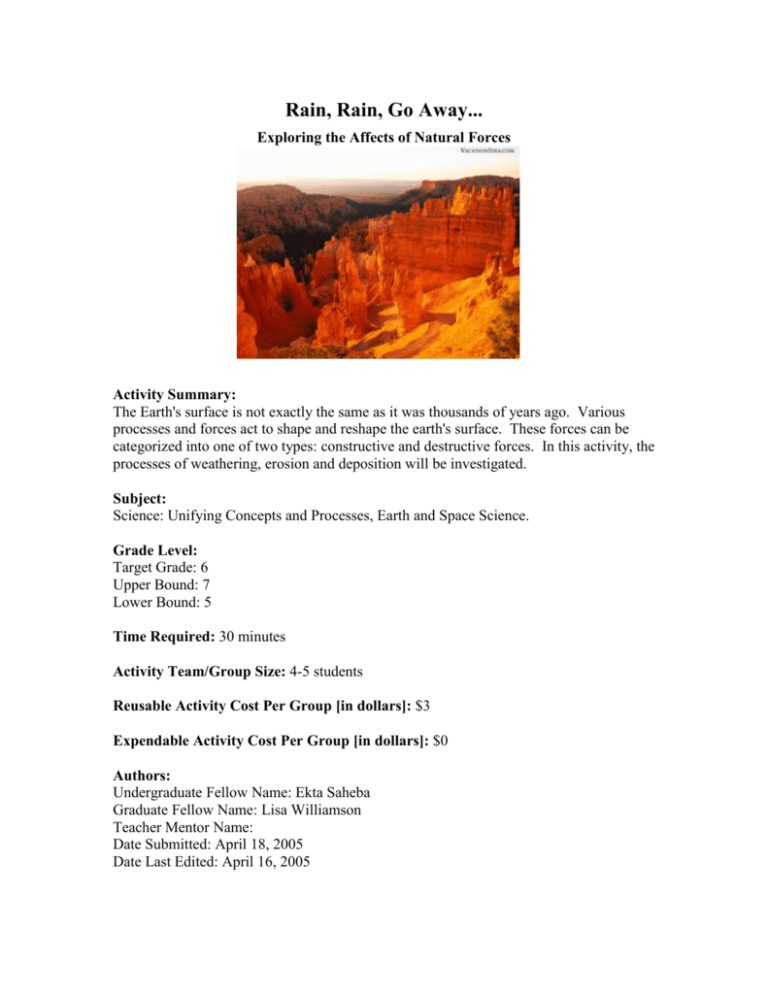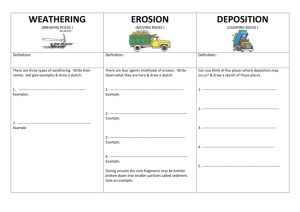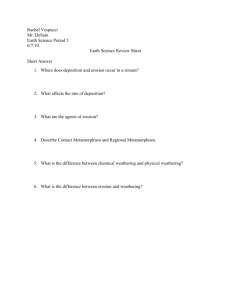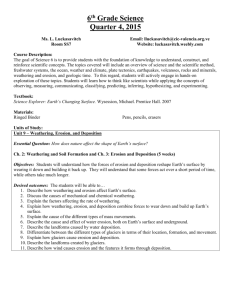Forces of Nature Activity Plan
advertisement

Rain, Rain, Go Away... Exploring the Affects of Natural Forces Activity Summary: The Earth's surface is not exactly the same as it was thousands of years ago. Various processes and forces act to shape and reshape the earth's surface. These forces can be categorized into one of two types: constructive and destructive forces. In this activity, the processes of weathering, erosion and deposition will be investigated. Subject: Science: Unifying Concepts and Processes, Earth and Space Science. Grade Level: Target Grade: 6 Upper Bound: 7 Lower Bound: 5 Time Required: 30 minutes Activity Team/Group Size: 4-5 students Reusable Activity Cost Per Group [in dollars]: $3 Expendable Activity Cost Per Group [in dollars]: $0 Authors: Undergraduate Fellow Name: Ekta Saheba Graduate Fellow Name: Lisa Williamson Teacher Mentor Name: Date Submitted: April 18, 2005 Date Last Edited: April 16, 2005 Parent Lesson Plan(s): This activity is a stand-alone activity, but can easily be modified to supplement a relevant module. Activity Plan: Preparations: Before beginning the activity, a teacher should take the Styrofoam cups and carefully poke 3 holes on the bottom of the cups. Each hole should be about 0.5 cm in diameter (about the diameter of a pen or pencil). Activity Procedure Part I: 1. Carefully mix the dirt with the rocks and pebbles in the bakeware. 2. Each group forms a mountain ridge along the short edge of their bakeware. Make sure each group firmly packs the dirt to correctly simulate a mountain. 3. Take the Styrofoam cup and plug the holes on the bottom with one hand while another group member fills the cup with 75mL of water. 4. Carefully hold the cup above the 'mountain ridge' and remove the hand to unplug the holes on the bottom. 5. Observe how the simulated rain affects the dirt on the mountains and where erosion and deposition take place. Activity Procedure Part II: 1. Have the students make a river channel dug into the dirt, rocks, and pebbles. The students can make any kind of river channel they would like: a straight river, a meandering (curving) river, or a braided river. 2. One group member can tilt the bakeware at an angle (approximately 45°). 3. Another group member will fill a cup (one with no holes at the bottom) with water and carefully pour it into the beginning of the river channel. 4. Observe what happens to the shape of the river and the river banks as the water flows down the river. 5. If time allows, have the students design another type of river to compare the results. Assessment: Have each group of students sketch out a picture of the mountain ridge, and the cup of water being used, and label where erosion and weathering is taking place, and where deposition is occurring. Then each group can sketch before and after pictures of their river channels and label on the after picture where the river banks underwent erosion and deposition. A discussion should take place on where, in the real world, deposition, weathering, and erosion can be seen. (Deposition can be seen in river deltas and beaches, weathering can be seen in the smoothing out of rocks in streams, while water erosion can be found at the Grand Canyon, and wind erosion can be seen in sand dunes of the Sahara.) Also discuss why the rocks and pebbles did not erode but the dirt seemed to do so. (Harder elements do not erode as easily as softer ones). Learning Objectives: Science 6.3 (C) Represent the natural world using models and identify their limitations 6.6 (A) Identify and describe changes to an object acted on by a force Vocabulary / Definitions: Constructive forces - processes which raise or build up the surface of the Earth Deposition - process of depositing sediment in a new location Destructive forces - processes which lower the surface of the Earth Erosion - a natural process by which material is worn away from the Earth's surface Weathering - any of the chemical or mechanical processes by which rocks exposed to the weather undergo changes in character and break down. Materials List: Each group will need the following: 13" x 9" cookie sheet with raised edges 3 cups of damp dirt 1/2 cup of various small pebbles and rocks 75 mL of water Styrofoam cup








